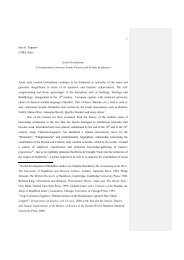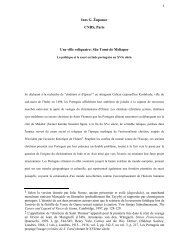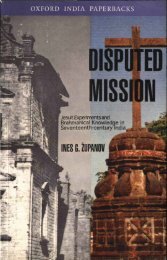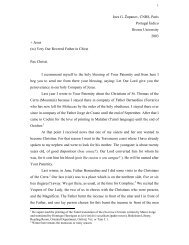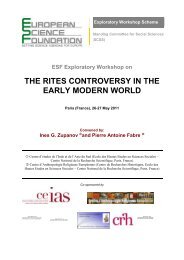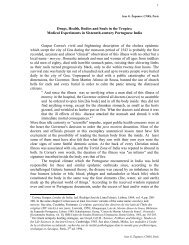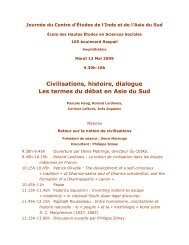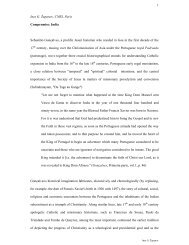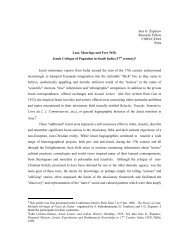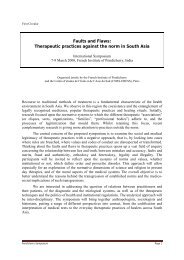Professional Missionary and Orientalist Curator ... - Ines G. Županov
Professional Missionary and Orientalist Curator ... - Ines G. Županov
Professional Missionary and Orientalist Curator ... - Ines G. Županov
Create successful ePaper yourself
Turn your PDF publications into a flip-book with our unique Google optimized e-Paper software.
211 <strong>Professional</strong> <strong>Missionary</strong> <strong>and</strong> <strong>Orientalist</strong> <strong>Curator</strong><br />
Emanuele, took shape under various titles <strong>and</strong> topics. Paulinus sifted<br />
through, classified, pruned <strong>and</strong> prepared for print documents <strong>and</strong> materials<br />
from his prodigious manuscript collection, including his fieldwork<br />
diaries. Within five years that he spent in Rome as a professor<br />
of Oriental Languages at the Propag<strong>and</strong>a Fide Mission seminary, he<br />
had managed to publish eight books: a Sanskrit grammar, Sidharubam<br />
seu Grammatica Samscrdamica (1790), a synthetic treatise on religious<br />
<strong>and</strong> civil organization in Brahmanic India, Systema Brahmanicum Liturgicum,<br />
Mythologicum, Civile, ex Monumentis Indicis Musei Borgiani<br />
Velitris, Dissertationibus historico-criticis (1791), a history of Christianity<br />
in India India Orientalis Christiana (1794), a few works on various<br />
South Asian alphabets <strong>and</strong> proverbs 21 , <strong>and</strong> two catalogues/inventories<br />
of Oriental manuscripts <strong>and</strong> objects, one for the Propag<strong>and</strong>a Fide<br />
<strong>and</strong> the other for the Museum in Velletri 22 .<br />
His travelogue, Viaggio alle Indie Orientali was not simply an effort<br />
at capturing a larger public, but also a way of quickly storing information<br />
that Paulinus probably knew he would not have enough time in<br />
near future to organize himself <strong>and</strong> that may thus be forgotten in the<br />
archives. Publishing Viaggio was also a way of inscribing himself onto<br />
a long list of travelogue writers through India, <strong>and</strong> to remind his readers<br />
of his first h<strong>and</strong> authority in things Indian.<br />
The most important way in which all these scattered fragments<br />
were brought together is translation. Translation was also the key to<br />
discovering both origins <strong>and</strong> the history of an object or a concept.<br />
Thus Paulinus wrote in the Viaggio, «With incredible inconvenience<br />
(fastidio) <strong>and</strong> labor (pena) I reunited these Indian Malabar names,<br />
21<br />
Alphabeta Indica, id est Granthamicum seu Sanscrdamico-Malabaricum, Indostanum<br />
sive Vanarense, Nagaricum vulgare et Talinganicum, Romae, Ex Typographia Sacrae<br />
Congregationis de Propag<strong>and</strong>a fide 1791, p. 24; De veteribus Indis dissertatio, in<br />
qua cavillationes auctoris Alphabeti Tibetani (A.A. Giorgi) castigatur, Romae, Antonius<br />
Fulgonius 1795, p. 54; Centum Adagia Malabarica cum textu originali et versione latina:<br />
nunc primum in lucem edita a Paulino a Sancto Bartholomaeo, Romae, Antonius Fulgonius<br />
1791, p. 12.<br />
22<br />
Paulinus a S. Bartholomaeo, Examen Historico-criticum Codicum Indicorum<br />
Bibliothecae Sacrae Congregationis de Propag<strong>and</strong>a Fide..., Romae, Ex Typographia Sacrae<br />
Congregationis de Propag<strong>and</strong>a fide 1792, p. 80; Id., Musei Borgiani Velitris codices<br />
avenses, peguani, siamici, malabarici, indostani, animadvesionibus historico-criticis castigati<br />
et illustrati. Accedunt monumenta inedita et Cosmogonia indico-tibetana..., Romae,<br />
Antonius Fulgonius 1793.




